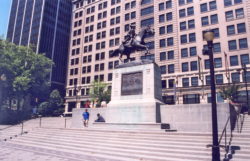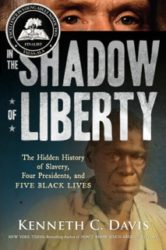[Updated 6/27/2023]
This is Part 8 of a blog series profiling the 56 men who signed the Declaration of Independence. The series begins here. The complete series can be found in this website’s Blog category.
In adopting and then signing the Declaration, these men were taking a significant risk. The closing words of the Declaration were not to be taken lightly.
…We mutually pledge to each other our Lives, our Fortunes , and our Sacred Honor.
Declaration of Independence (Source: National Archives https://www.archives.gov/founding-docs/declaration
But it is also true that at least 40 of these 56 men who pledged themselves to the idea that “All Men are created” and are entitled to “life, liberty and the pursuit of happiness” enslaved people. A “YES” following an entry means the Signer enslaved people; “NO” means he did not.
Minister turned whaleboat captain and lawyer. Self-taught planters’ sons. A Nay vote. A rare bachelor. And a veiled man. The next six signers:
•Thomas Nelson, Jr. (Virginia) Another son of a wealthy planter, he was a 37-year-old merchant-planter at the signing who enslaved more than 400 people. He raised money to supply troops and even commanded militia. Legend has it that he fired a cannon at his own Yorktown mansion during the 1781 siege when told that it was British headquarters. The war cost him financially and he was in ill health, retiring as Virginia’s governor and living on his plantation until his death at 50 in 1789. YES
•William Paca (Maryland) An attorney and wealthy planter’s son, he was 35 at the signing. A patriot leader in somewhat conservative Maryland, Paca (pronounced Pay-cah) helped bring the state to favor independence at Philadelphia. He raised funds for the war effort and later, as Congressman, worked to support veterans.
During the Constitutional debate, Paca was a firm believer in states rights and individual rights, and led the Antifederalist movement in Maryland.

William Paca by Charles Willson Peale MSA SC 4680-10-0083 Source Maryland State House
“Even though he had many reservations, he voted in 1788 to approve the Constitution. He advocated 28 amendments to the Constitution, including those on freedom of religion, freedom of the press, and protection against judicial tyranny, and many of his proposed amendments became a part of the Bill of Rights.”
[Source: The Society of the Descendants of the Signers of the Declaration.]
He was twice married, but both wives died after childbirth, and Paca also fathered two children out of wedlock, one to a mixed race woman while serving in Philadelphia, according to the Society of the Descendants. He was later appointed a federal judge by President Washington, and was in that post at his death in 1799 at age 58. YES

Robert Treat Paine (Courtesy: Massachusetts Historical Society, Boston, Massachusetts)
•Robert Treat Paine (Massachusetts) Overshadowed by two Adamses and Hancock, he was a minister turned attorney, 45-years-old at the signing, who had also been a sea captain on a whaler.
“In 1754, as Captain of the Seaflower, he led a whaling expedition from Cape Cod to Greenland and left behind what is believed to be the earliest illustrated log of a whaling venture kept by an American.” [Source: Society of the Descendants of the Signers]
He is perhaps best known as one of the prosecutors in the 1770 trial of the British soldiers charged in “Boston Massacre.” His friend and fellow delegate John Adams had served successfully as their defender. In 1780, he was among the founders of the American Academy of Arts and Sciences, one of the first American groups dedicated to expanding scientific knowledge and learning. After the war, he remained active in Massachusetts politics, becoming the state’s Attorney General, and was named a state judge by John Hancock until his retirement in 1804 due to deafness. He died in 1814 at age 83. NO
•John Penn (North Carolina) A wealthy planter’s son who taught himself to read and write, he was a 36-year-old attorney at the signing. He remained in Congress and was one of the signers who also signed the first American constitution, the Articles of Confederation. He retired to private law practice and died in 1788 at age 48. YES
•George Read ( Delaware) Among the conservative delegates, he was a 42-year-old lawyer at the time of the signing but had voted against independence on July 2. He served in state offices until ill health forced his resignation. But he returned to Philadelphia to take part in the Constitutional convention and was leading voice for small states’ rights and led the ratification forces in Delaware, the first state to ratify the Constitution. Elected to the Senate, he resigned to take a judgeship in Delaware before his death in 1798 at age 65. YES
•Caesar Rodney (Delaware) Another self educated attorney, son of a planter, he was 47 at the signing. He is perhaps best known for an 80-mile ride in a storm to break a deadlock that put Delaware in the Independence column –which cost him favor with conservatives in his home state. He later wrote in a letter:
“I arrived in Congress (tho detained by thunder and rain) time enough to give my voice in the matter of independence . . . We have now got through the whole of the declaration and ordered it to be printed so that you will soon have the pleasure of seeing it.” [Source: The Society of the Descendants]

Statue of Caesar Rodney on his ride-Rodney Square Wilmington, DE (Public Domain)
Rodney also exemplifies the Great Contradiction of the Declaration, as he had earlier introduced legislation against the foreign slave trade:
“In 1766, as the Speaker of the [Delaware] Assembly, he introduced a bill to prohibit the importation of slaves into Delaware. At this time he was living in Byfield, a plantation of 1,000 acres, and owned 200 slaves. It is clear that he was pondering questions of the Colony’s and Mankind’s liberty and freedom. Indeed, at his death fourteen years later, he directed that all his slaves should be freed then, or shortly thereafter.” [Source: The Society of the Descendants]
One of the three bachelor signers (Francis Lee and Thomas Lynch were the others), Rodney remained in the Congress until he became Delaware’s state president. A cancerous growth on his face was untreated and he covered it with a silk veil, worn for a decade before his death in 1784 at age 55. YES
Read more about the place of slavery in the Founding of the United States in my book IN THE SHADOW OF LIBERTY.
